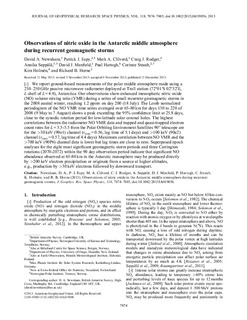| dc.contributor.author | Newnham, David A. | |
| dc.contributor.author | Espy, Patrick Joseph | |
| dc.contributor.author | Clilverd, Mark A. | |
| dc.contributor.author | Rodger, Craig J. | |
| dc.contributor.author | Seppälä, Annika | |
| dc.contributor.author | Maxfield, David J. | |
| dc.contributor.author | Hartogh, Paul | |
| dc.contributor.author | Straub, Corinne | |
| dc.contributor.author | Holmén, Kim | |
| dc.contributor.author | Horne, Richard B. | |
| dc.date.accessioned | 2018-02-09T14:12:47Z | |
| dc.date.available | 2018-02-09T14:12:47Z | |
| dc.date.created | 2014-02-27T12:14:21Z | |
| dc.date.issued | 2013 | |
| dc.identifier.citation | Journal of Geophysical Research - Space Physics. 2013, 118 (12), 7874-7885. | nb_NO |
| dc.identifier.issn | 2169-9380 | |
| dc.identifier.uri | http://hdl.handle.net/11250/2483789 | |
| dc.description.abstract | We report ground-based measurements of the polar middle atmosphere made using a 230–250 GHz passive microwave radiometer deployed at Troll station (72°01′S 02°32′E, L shell of L = 4.8), Antarctica. Our observations show enhanced mesospheric nitric oxide (NO) volume mixing ratio (VMR) during a series of small recurrent geomagnetic storms in the 2008 austral winter, reaching 1.2 ppmv on day 200 (18 July). The Lomb normalized periodogram of the NO VMR time series averaged over 65-80 km for days 130 to 220 of 2008 (9 May to 7 August) shows a peak exceeding the 95% confidence limit at 25.8 days, close to the synodic rotation period for low-latitude solar coronal holes. The highest correlations between the radiometer NO VMR data and trapped and quasi-trapped electron count rates for L = 3.5-5.5 from the Polar Orbiting Environment Satellites 90° telescope are for the >30 keV (90e1) channel (rmax = 0.56, lag time of 5.1 days) and >100 keV (90e2) channel (rmax = 0.57, lag time of 4.4 days). Maximum correlation between NO VMR and the >700 keV (90P6) channel data is lower but lag times are close to zero. Superposed epoch analyses for the eight most significant geomagnetic storm periods and three Carrington rotations (2070-2072) within the 90 day observation period indicate that significant NO abundance observed at 65-80 km in the Antarctic mesosphere may be produced directly by >200 keV electron precipitation or originate from a source at higher altitudes, e.g., production by >30 keV electrons followed by downward transport. | nb_NO |
| dc.language.iso | eng | nb_NO |
| dc.publisher | American Geophysical Union | nb_NO |
| dc.title | Observations of nitric oxide in the Antarctic middle atmosphere during recurrent geomagnetic storms | nb_NO |
| dc.type | Journal article | nb_NO |
| dc.type | Peer reviewed | nb_NO |
| dc.description.version | publishedVersion | nb_NO |
| dc.source.pagenumber | 7874-7885 | nb_NO |
| dc.source.volume | 118 | nb_NO |
| dc.source.journal | Journal of Geophysical Research - Space Physics | nb_NO |
| dc.source.issue | 12 | nb_NO |
| dc.identifier.doi | 10.1002/2013JA019056 | |
| dc.identifier.cristin | 1118796 | |
| dc.relation.project | Norges forskningsråd: 223252 | nb_NO |
| dc.description.localcode | ©2013. American Geophysical Union. All Rights Reserved. | nb_NO |
| cristin.unitcode | 194,66,20,0 | |
| cristin.unitname | Institutt for fysikk | |
| cristin.ispublished | true | |
| cristin.fulltext | original | |
| cristin.qualitycode | 2 | |
